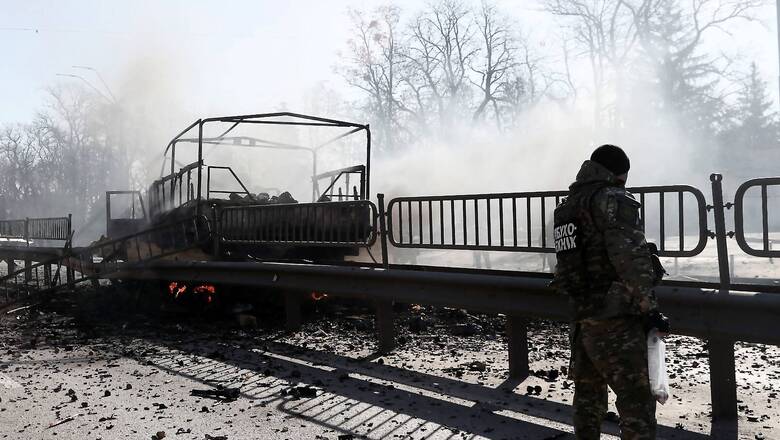
views
War and conflict have always disrupted and jeopardised the way people lead their lives. They not only claim lives and livelihoods but also crush the healthcare system and essential services. There is always a possibility of chronic shortage of healthcare staff along with mass displacement, death and injury. Coupled with an ongoing COVID-19 pandemic, a war can devastate an already overworked healthcare system. In the ongoing military invasion of Ukraine by Russia, it is impossible to ignore its impact on Ukraine’s health system and its people’s well-being.
Russian Invasion of Ukraine
On February 24, 2022, Russian President Vladimir Putin declared a military invasion of Ukraine, its western neighbour. Ukraine has been assaulted from the north, east and south. This is the largest attack on a European nation since World War II. The war was started to prevent Ukraine from joining NATO, a military alliance made up of 28 European countries and two North American countries dedicated to maintaining peace and security in the North Atlantic region. On the first day of Russian invasion, at least 137 people were killed. As the war progresses, the death toll will only rise.
COVID in Ukraine
The seven-day average of COVID-19 cases in Ukraine on February 24 stood at 26,740. For a country with an estimated population of 4.4 crore, this seems like a big number. Moreover, official statistics indicate that roughly 35.6 per cent of the total Ukrainian population has received their first dose of vaccine. As of February 20, 2022, the numbers for a second and a booster dose stood at 34.3 per cent and 1.6 per cent, respectively.
Disruption of Health System in Ukraine
Ukraine has been trying to move from its inefficient and corrupt Soviet-era healthcare system to a UK-style General Practitioner-led National Health Service. Under the older system, out-of-pocket expenditure formed half of all healthcare expenditure, where every other patient refuses or delays treatment due to costs. Ukraine has one of the highest mortality rates in the world with rebel-controlled eastern Ukraine lagging further in health indicators.
Donetsk and Luhansk, controlled by the rebels, have seen a huge fall in their healthcare infrastructure post 2014. With Russia advancing in Ukraine, there is a possibility that either Russia-backed rebels or a government friendly to Russia will take over. One can expect a prolonged guerilla war being waged against the Russian-backed entity. This guerilla war will add to the damage inflicted by the conventional war on the healthcare infrastructure of Ukraine.
With the pandemic still raging and the likelihood of greater damage to the healthcare system, there will be excess deaths in addition to those caused by war injuries. Because of the country’s low vaccination coverage, most Ukrainians are susceptible to COVID-19 infection. Recent developments have shown that people have taken refuge at underground metro stations to save their lives. Kyiv’s extensive subway system doubles as bomb shelters. It is the oldest and largest underground network in the eastern European country. Basements and bunkers are full of people. Moreover, there has been news of people migrating to other cities and towns in search of safer places. In situations like these, social distancing and masking are not prioritised. The health repercussions may not be apparent immediately, but the situation can deteriorate in a matter of time.
ALSO READ | War in Ukraine: For India, It Will No Longer be Business as Usual with Russia or US
Role of International Aid Agencies
Aid in active warzones is quite difficult to reach. In eastern Ukraine, it took weeks for aid agencies to provide aid. With no flight zones and restriction on movement of people and goods, it is an arduous task for aid organisations to reach the affected. Supply of vaccines, medicines and food will take a hit. Aid in active warzones is different from areas where natural disasters have stuck because of continuous shelling and firing. This, along with the disdain for Europeans in eastern Ukraine, would make the job of aid organisations that much difficult. For instance, Médecins Sans Frontières/Doctors Without Borders has found it tough to work in rebel-controlled areas of Ukraine since 2015. Unless both sides allow aid agencies to work and let humanitarian aid flow in, it would be quite impossible for these organisations to help.
Conflicted regions have historically shown to become ideal places for outbreaks and diseases. Syria and Afghanistan have faced health challenges, such as disruption of vaccination programmes and collapse of health infrastructure. If this conflict continues for long, it would devastate Ukraine’s health system. The humanitarian support from the international community undoubtedly will not meet the demands of the entire population but it will definitely help to reconstruct some broken health services and give basic healthcare access to the Ukrainian population.
Mahek Nankani is Assistant Programme Manager, The Takshashila Institution. Harshit Kukreja is Research Analyst, The Takshashila Institution. The views expressed in this article are those of the authors and do not represent the stand of this publication.
Read all the Latest Opinion News and Breaking News here


















Comments
0 comment